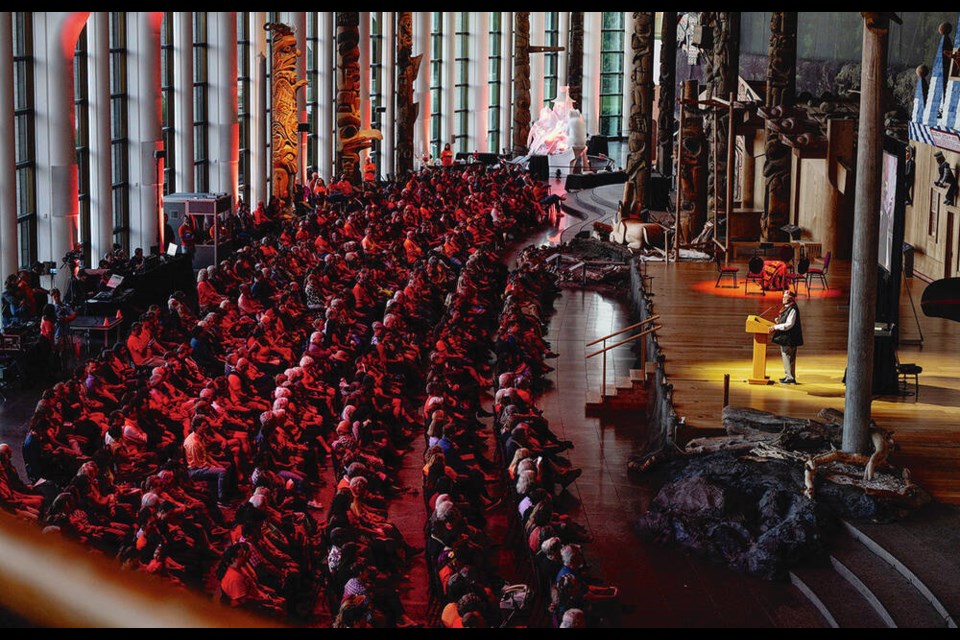A Kwakwaka’wakw artist’s memorial carving dedicated to those who attended residential schools ended its three-year cross-country journey from Port Hardy on Monday when it was formally unveiled as a display in the Canadian Museum of History’s permanent collection.
Indian Residential School Memorial Monument, a stark black-and-orange pillar covered with 130 individually hand-carved unsmiling faces created by master carver Stanley Hunt, was inaugurated in front of a crowd of around 900 people that included Canada’s chief of defence staff Gen. Jennie Carignan.
About 50 Kwakiutl community members travelled from Fort Rupert (T’sakis) to usher in the monument’s next chapter, at the museum in Gatineau, Que., across the Ottawa River from Ottawa.
Hunt said the delegation was met by an Algonquin Elder on Monday morning in accordance with Algonquin protocol. “We answered them with our drum and song, the songs of seeing the monument here in Ottawa for a journey all the way across the country.”
Everywhere they stopped during the journey, residential-school survivors came to see the carving, he said.
Many, overcome with emotion, shared stories of their time in residential school, including some who had never talked about their experiences before, he said.
The carving spent several weeks in Regina where about 4,000 people visited.
The 18-foot-tall, four-feet-wide carving topped by a raven features an inverted cross, as well as an upside-down maple leaf and abbreviations for the RCMP and the North-West Mounted Police.
“A person might be a bit offended when they see that the cross is upside down. But I’m more offended that they got away with murdering children for 150 years,” Hunt said.
It’s meant to highlight the role that those institutions played in the forced displacement of Indigenous children to residential schools where they were denied their culture, language, and art, he said.
More than 150,000 children were forced to attend residential schools. Many survivors detailed the horrific abuse they suffered in testimony for the Truth and Reconciliation Commission.
An estimated 6,000 children died while attending the schools, although experts say the actual number could be much higher.
There have been fewer than 50 convictions linked to the abuse at residential schools, according to a Truth and Reconciliation Commission report.
Hunt, whose carvings can be found all over Vancouver Island and around the world, said the monument has been the most emotionally taxing and complex piece of art in his career.
Hunt carved the piece with the assistance of two other carvers, Rey Dickie and Mervyn Child over the course of about a year.
The work included many contributions from the people of Port Hardy.
Students from Wagalus School in Port Hardy — some of whom were present at the museum on Monday — helped to paint the monument’s black coating.
Port Hardy RCMP and members of the Canadian Coast Guard also contributed, he said.
“One RCMP officer came by at least four times in full uniform, seeing if there’s some more she could do … she painted probably more than rest of them,” he said.
Canadian Museum of History CEO and president Caroline Dromaguet said the museum is honoured to receive Hunt’s work.
“It is our shared responsibility to listen, bear witness, and work towards a better shared future,” she said in a statement. “Its prominent placement in its own dedicated space will ensure that the children of this country’s residential school system are never forgotten.”
The carving can be found in a first floor gallery dedicated to Indigenous art. Museum curator Kaitlin McCormick said the piece was acquired for $450,000.



